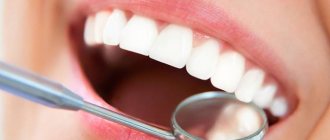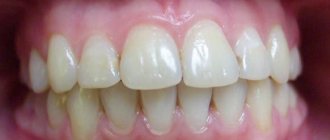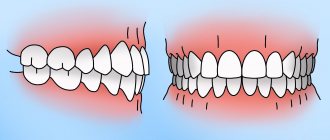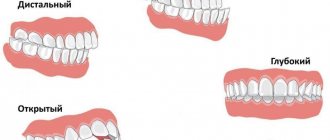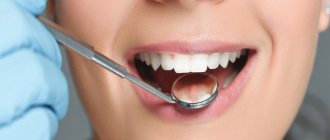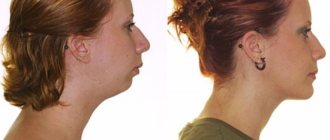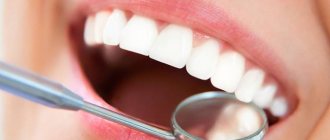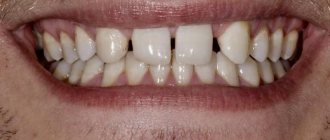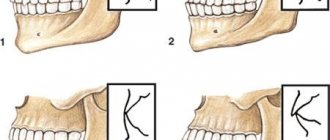Quite often in the practice of orthodontists, the following situation arises: they are approached by patients who have not thought about correcting their bite and sometimes did not even know that they had any problems, but were planning to install implants. But the implantologist refused to carry out treatment, referring him first to an orthodontist. Why is this happening?
The work of an implantologist and an orthodontist is connected, since the common goal is one - to bring the condition of the teeth as close as possible to ideal
To understand, you need to understand what is special about implants and how the bite affects them.
How are implants fundamentally different from other types of prosthetics?
Previously, prosthetics meant the installation of individual crowns or bridges. One crown can be installed on a dilapidated tooth, provided that its root is preserved. If a tooth is lost, you will have to grind down the nearest healthy teeth and install a bridge of crowns and an intermediate element on them.
A bridge consists only of crowns and an intermediate element; it does not replace the roots in any way
Although such prosthetics are still performed, it has disadvantages. Crowns functionally replace only the visible part of the tooth, allow chewing and return an attractive appearance to the smile, but do not restore the root of the tooth.
And when the roots of the teeth are lost, the jawbone gradually begins to thin out. The process of resorption (resorption) of bone tissue, which begins in all people after 35–40 years, occurs faster with tooth loss. The remaining teeth suffer from this.
The fundamental difference between implants is that they are installed in the bone, in place of the tooth root.
The most important stage in prosthetics is installation of the implant into the bone.
Thus, when chewing, the load is transferred to the implant, the jaw bone “responds” by supporting the renewal of bone tissue cells in this place. The functions of the tooth are fully restored, and there is no thinning of the jaw bone.
Therefore, implantation is in many cases the optimal method of prosthetics. But this is especially true for young people, those who are missing 1-2 teeth, and the rest are in good condition. It is implantation that will allow you to replace lost teeth in such a way that you can maintain the health of the remaining ones for many years.
Material used for work
Prostheses are made from stainless steel, dental ceramics, plastic and a combination of the above materials.
- Steel
The most common material is stainless steel due to its strength, manufacturability and low price. For prosthetics, a socket is used, which is stamped at a factory or in a clinical laboratory. The top of the workpiece is coated with ceramics, plastic, or titanium nitride is sprayed for a “gold-like” coloring.
- Metal alloys
Alloys of gold, silver, cobalt, and titanium are used to make prostheses. Such crowns do not cause allergies, are resistant to oral fluid, and have a long service life. Disadvantage: low aesthetics.
- Metal ceramics
Their base is metal, resistant to cracking. Ceramic mass is applied on top, which can be given an aesthetic appearance.
- Ceramics
This material is closest in color to tooth enamel. Dental ceramics are highly durable and can withstand heavy chewing loads.
- Metal-plastic
Plastic crowns are fragile and are used temporarily until permanent structures are made. Metal-plastic dentures have a base made of metal and an applied plastic coating, which looks aesthetically pleasing. With careful use, these crowns will last for several years.
Stages of crown installation
You will have to visit the dentist's office several times when getting dentures. It is necessary to examine the teeth, take x-rays of problematic units, sharpen them, and select materials. An impression is taken from the tooth, from which a crown will be made in the laboratory. It is bleached, sanded, and only then installed.
Care Tips
Crowns do not require special care. It is necessary to brush your teeth 2 times a day. It is better to use flosses, rinses, brushes. It is not recommended to chew hard foods. It is advisable to quit smoking.
Alternative methods
| Click to sign up for a FREE consultation |
The bite can be corrected in other ways, for example, by doing exercises, installing mouth guards, fixed orthodontic devices, or undergoing surgery.
During gymnastics, dysfunction of the muscles of the face and jaw is put in order. This is what often leads to malocclusion.
Orthodontic structures (braces) use metal arches to act on abnormally located teeth. Disadvantage: long wearing time, high price.
Mouth guards are removable polymer pads that cannot be worn all the time. Operations to correct the bite are carried out in difficult cases when other methods do not help.
A good bite ensures proper chewing of food, good speech and a beautiful smile. Due to improperly positioned teeth, complications can develop, including severe migraines and ear diseases.
But what do braces have to do with it?
An important feature of implants is that when chewing they experience stress, and it is transferred to the internal part (pin). Therefore, it is very important to correctly calculate the location of the implant and its angle of inclination. The crown that will be installed on the implant after healing must be in the correct position relative to the remaining teeth so that there is no increased load when closing. Otherwise, the implant will not last long.
Each implant has its own installation angle, which is calculated individually
Preparation for implantation includes modeling the process in a special program. This is a very important stage on which the success of treatment depends. And it is at this stage that a problem may arise: if the bite is incorrect, implants most often cannot be installed, since it simply will not be possible to do it correctly.
Implantation is a complex and expensive procedure. In good clinics, doctors give a guarantee for the work performed, and this, as a rule, is not 1 year, but much longer. Therefore, an experienced doctor will not undertake treatment for a malocclusion, since he will not be able to guarantee a good result.
Sometimes bite problems are not visible to the person himself; for example, with a direct or deep bite, the teeth can be straight and the smile looks generally attractive. But still, this creates a problem for implantation.
Example: teeth are straight, but the occlusion is incorrect
And although treatment by an orthodontist will seriously delay the day when prosthetics can be performed (by at least several months), this stage cannot be skipped.
Consultation with specialists
At a joint consultation, an orthopedist, an orthodontist and a neuromuscular dentist explained to the patient that the problem could not be solved without serious bite correction. It is important to achieve not only an aesthetic result, but also to maintain the health of the temporomandibular joints. Prosthetics for worn teeth in a habitual bite can cause additional discomfort, headaches, and increased pain in the TMJ. Prosthetics will not be durable; crowns will chip in the same way as teeth, since the source of the problem is the incorrect position of the lower jaw relative to the skull and increased tension in the TMJ. Without correcting the incorrect position of the jaw, no measures will produce results. Therefore, prosthetics must be performed in the correct bite (correct does not mean habitual).
How to quickly and easily carry out treatment before implantation
Those who have not previously thought about treatment with an orthodontist are not motivated to wear braces, and this is understandable. But now, thanks to aligners, it is possible to undergo treatment in a short time. In addition, such an orthodontic system is invisible to others. Aligners are superior to braces in most important parameters and are best suited for preparation for implantation, since treatment with them is quick.
Preparation for implantation can take from several months to a year, depending on the initial situation. But such comprehensive treatment will bring benefits in the future, since with a correct bite it is easier to maintain healthy teeth.
It is better to correct the bite as early as possible. But if this does not work out, then you can contact an orthodontist at any age, even at 45–50 years old and later (nowadays older patients are not uncommon).
Stage II - tooth implantation
After removing the braces, implant surgeon V.P. Alaverdov installed an Astra Tech dental implant for the patient. The operation lasted 30 minutes and was performed under sedation (in medical sleep). Healing took several months.
The fixed orthotic remains on the teeth until the final dental prosthetics. The dimensions of the orthotic will be harmoniously distributed between the antagonist teeth. Crowns on the teeth will fix the correct position of the bite.
Stage IV - dental prosthetics
Prosthetics on an implant, as well as prosthetics of teeth in the lateral sections above and below in a physiological and stable musculoskeletal position of the lower jaw, created all the prerequisites for the correct functioning of the TMJ. Crowns are installed on the teeth on a zirconium dioxide frame.
After dental prosthetics:
Preparation for orthodontic treatment
Before fixing the braces, the patient visited surgeon V.P. Alaverdov for the removal of a failed wisdom tooth.
Commentary by surgeon V.P. Alaverdova: “After the initial consultation with S.V. Zukor and subsequent comprehensive consultation with specialists, the patient was referred to me, and I carried out the first stage of the approved treatment plan. 1.8 tooth was removed. When removing a wisdom tooth, atraumatic techniques were used to preserve bone and gums. Two hemostatic sponges were placed in the socket and laser biostimulation was performed. The action of laser radiation sterilizes the hole, preventing possible complications and accelerating tissue healing. The removal was successful, healing without complications.”
Hygienist E.P. Smirnova performed Air Flow teeth cleaning, ultrasonic tartar removal, and minor gum treatment. This stage is performed free of charge as part of a promotion for patients undergoing complex orthodontic treatment.
Endodontist R.A. Akopov treated tooth 1.1 (front upper tooth on the right). Treatment of tooth canals, as well as placement of fillings, is performed using a dental microscope. Root canal treatment uses high-tech instruments to penetrate the crooked, narrow canals of teeth and provide the most thorough treatment possible. Treatment of canals under a microscope provides a full guarantee of quality and a long-term prognosis, which is important when installing expensive denture structures.
Commentary by endodontist R.A. Akopova: “The patient was referred by the chief physician S.V. Tsukor for revision of tooth 1.1. After diagnostics, including computed tomography, a decision was made to re-treat tooth 1.1, since an inflammatory process was observed behind the apex of the tooth. Retreatment used a microscope, nickel-titanium rotating instruments, and a self-adapting SAF file. The treatment was successful."
Ceramic inlay - microinsert that replaces a filling
As you know, before filling a tooth affected by caries, the doctor first excises its non-viable tissue. Therefore, in case of secondary caries, when the filling has to be re-placed, due to the significant size of the cavity, the tooth is already practically destroyed. The patient is recommended to undergo depulpation and cover it with a crown.
Recurrence of caries occurs due to the lack of proper sealing between the walls of the tooth and the composite filling, which decreases in volume during polymerization. The ceramic inlay is free of this drawback; it is manufactured individually with high precision and therefore fits tightly to the tooth. The ceramic material of the inlay does not shrink and does not change color or shape during use.
Microprosthetics with inlays is performed on teeth whose defects make up up to 30% of the volume of their coronal part, and allows you to create exact copies of teeth with the correct shape of the chewing surface.
The essence of using structures
With a correct bite, the upper front teeth protrude forward in relation to the lower ones and overlap them by one third of the height. In this case, each chewing element is in contact with two antagonists, their tubercles overlap each other.
There are different ways to correct malocclusion. One of them is the installation of permanent crowns.
An artificial crown is a prosthesis placed on the prepared surface of the problem unit protruding above the gum.
The purpose of prosthetics can be different - restoration of the anatomical shape, correction of minor crowding, elimination of chewing and speech dysfunction, restoration of smile aesthetics.
But in any case, its essence is to give the jaw row a normal shape, which ensures the proper functioning of the dentofacial apparatus.
Reviews
It is difficult to imagine a person who has not had a single crown installed in his entire life. Mostly these are steel stamped products.
A much smaller number of people wear prostheses made of metal-free ceramics and zirconium oxide. If you are one of them, please share your operating experience.
A few words of comment at the bottom of this page will not take up much of your time, but will be very useful for those who are about to undergo prosthetics.
If you find an error, please select a piece of text and press Ctrl+Enter.
Tags dental crowns bite
Did you like the article? stay tuned
Previous article
What are the best crowns to put on dental implants and why?
Next article
Stages of treatment with braces or getting a perfect smile from A to Z
Determining the correct bite
Only a specialist can judge the state of the bite. The correct bite is determined at the moment of complete closure of the teeth. Correctness depends on the evenness and density of the teeth adjacent to each other.
Dentists test the correctness of the bite by squeezing a special plate between the teeth.
People who have a correct bite can hardly imagine what difficulties even the slightest deviation can present - this circumstance speaks of the natural connection between the process of eating and other aspects of human life.
Those who have even a slight malocclusion know how difficult it is to pronounce some sounds and how difficult it is to chew food, and what a challenge a dialogue with a new acquaintance can be.
Bite testing may show the following abnormalities:
- When the jaw moves forward , there is an additional load on the muscle that fixes the lower jaw. This deformation of the jaw joint can contribute to the occurrence of pain in the temporal region, as well as provoke involuntary complete closure of the jaws. Constant stress without muscle relaxation leads to pain and fatigue.
- When the jaw moves back, the airways narrow and blood circulation becomes difficult. These deficiencies lead to possible respiratory arrest and metabolic disorders during sleep.
- Malocclusion of any kind leads to early tooth loss and can become a prerequisite for the development of diseases of the endocrine system, heart failure and even a shortening of life.
Prevention and, if necessary, treatment of malocclusion is a prerequisite for physical and social health.
Dentists say that occlusion is, first of all, complex connections between the interactions of the body system, and only then the aesthetic side of the matter.
